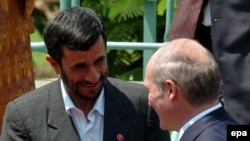But apparently the NAM still has some life in it. Some leaders of developing countries welcome it as a forum to make themselves heard and possibly capture a headline or two. For international pariahs like Belarus, Burma, or Zimbabwe, it is one of the few organizations from which they have not been ousted or in which they have not been censured. For would-be powers like India, Argentina, or South Africa, the movement provides an opportunity for them to be very big fish in an international pond.
Yugoslavia To The Fore
It was Indian Prime Minister Jawaharlal Nehru who coined the term "nonalignment" in a 1954 speech in Colombo, in what was then called Ceylon. The movement itself was founded the following year at a conference in Bandung, Indonesia, as a result of the efforts of Nehru, Indonesia's President Sukarno, Yugoslavia's Josip Broz Tito, Egyptian leader Gamal Abdel Nasser, and Kwame Nkrumah of what would soon become Ghana. For Tito, it provided a stage and ideological underpinning for a foreign policy in search of direction since Soviet dictator Josef Stalin expelled him from the "socialist camp" in 1948 for refusing to take orders.
For decades, the NAM and its dignitaries regularly graced the socialist Yugoslav media. In 1956, Tito played host to Nasser and Nehru on the island of Brioni, now better known by its Croatian name Brijuni. At least until recently, rooms filled with stuffed leather chairs, heavy dark wooden furniture, and solid crystal ashtrays could be seen there, in his villa along Lake Bled, and at Tito's other retreats, recalling the days when he basked in his role as a leader of nonalignment.
Yugoslavia's role in the movement brought it advantages in trade and international exposure. For some people, it meant an opportunity to travel to and work or study in distant lands. Although Yugoslav communism was generally antagonistic toward all religions, some Yugoslav Islamic religious leaders were given opportunities to represent their country in the Middle East and elsewhere in the Muslim world, and some relished their new role.
Post-Cold War Focus On Europe
But with the collapse of communism and breakup of Yugoslavia, the NAM seemed as much an anachronism to many former Yugoslavs as their old flag. Some might view it with nostalgia, but it was clearly history. Eyes were now focused on joining the EU and regaining an important privilege that Yugoslavs had once enjoyed in socialist times but no longer did, namely visa-free travel throughout Europe.
It thus came as a bit of a surprise to many in former Yugoslavia that the NAM recently held a summit in Havana to be attended by representatives of no fewer than 118 countries, including several from Europe. But among the European members, only two heads of state were present -- Belarusian President Alyaksandr Lukashenka and Croatian President Stipe Mesic.
It is no secret that Mesic has moved somewhat to the left in recent years. But it came as a bit of a jolt to many Croats that he would go to a gathering where no EU or NATO head of state would be present, but instead would probably see Venezuela's Hugo Chavez and Zimbabwe's Robert Mugabe.
Controversy In Croatia
Indeed, Mesic's appearance there sparked discussions in the Croatian media. Many commentators, including his political rivals from the governing Croatian Democratic Community (HDZ), suggested that Croatia could have been represented equally well by a deputy minister or other low-ranking official. There was also the question as to whether Croatia needed to be present in Havana at all at a time when Zagreb's main foreign policy concern is that its prospects for EU membership seem to be on indefinite hold.
Mesic, however, maintained he had two important reasons for going to Cuba. One was to promote trade, including with far-away countries with which Croatian firms had good relations dating back to socialist times. The second was to drum up support for Zagreb's bid for a rotating seat on the UN Security Council in 2008.
Some commentators were not convinced and told RFE/RL's South Slavic and Albanian Languages Service on September 18 that the countries represented in Havana are not the ones that Croatia needs in its quest for EU membership. One expert pointed out, moreover, that UN member states support Security Council seat candidates according to the recommendations of regional blocs, so that it is vital for Croatia to line up European and not African or Asian backing. Other commentators pointed out that there were no obvious economic benefits derived from Mesic's presence at the summit. Only a representative of Mesic's Croatian People's Party (HNS) seemed confident that there was something to be gained by calling attention to Zagreb's historical links to nonalignment and pursuing business links in the developing world.
RFE/RL Balkan Report











